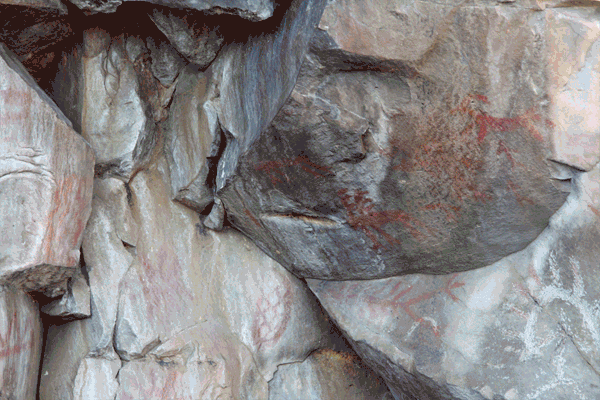I had a teacher once (Vicky) who posited with a straight face that the most important thing you can give to starving people is art. Now as then, I still vote for bread, or more specifically, an educational program that teaches sustainable farming and a financial package to help such an endeavor along, but the outlandishness of my teacher's claim haunts me to this day.
I wish I could remember the words my teacher used, her normally brash and cool character terrifyingly subverted by the threat of oh-my-god-actual-tears, as she tried to convince us, a handful of her young sculptor's in training, that what she said was true. But I can't. It was thirty years ago or so, and while that may not pose a great problem for gospel writers, it does tend to make me, at least, a little sketchy on details.
 |
| A gallery wall at the Portland Art Museum |
Art is a funny thing. It's hard to define. And, as with most things that enter the realm of culture and taste, people of privilege survey, record and contribute to its history and subtle nuances, ultimately creating a complex narrative or context to impose on the uninitiated. Art intellectuals might go on and on about what a painting says (overtly or symbolically) about motherhood or welfare states or perhaps feminism, but about half the people I know, seeing the same painting, will simply shrug their shoulders and comment matter-of-factly, "nice rack".
 |
| A gallery wall in a narrow rock shelter |
If you know culture and context, then you have a better chance of determining what art means. One of the problems for me is that when I chance to look at a 'gallery' of art that spans not only cultures, but centuries, I don't know for sure if I'm looking at...
 |
| An inscribed painting of mountain sheep |
a masterpiece,
 |
| Large scale 'public art' at the beginning of a once difficult river passage. |
graphic design,
 |
| d-stretch* enhanced detail of rock shelter image |
or graffiti .
 |
| Modern view from site of rock shelter. |
It doesn't help that the context for much of the rock art in the Columbia Gorge has been drastically altered by the serial damming of the
Markings that were still accessible when I was eleven have long been submerged under 'lake' Umatilla.
 |
| Preserved petroglyph at Columbia Hills State Park |
People did what they could to save bits and pieces from inundation by chipping them from their original sites and preserving them in arbitrary collections.
 |
| Horsethief Butte from the middle of the Columbia River. |
I do what I can to imagine the environment the way it must have looked hundreds of years ago.
Specialized software from Microsoft, called Photosynth, attempts to recreate three-dimensional space by linking together overlapping photographs. I've tried to use this software to help provide a better idea of what it's like to visit a largely intact rock painting gallery. (Note: There are 73 photos incorporated into the 'photosynth' so, depending on your connection speed, be patient and wait for images to snap into full resolution.)
When some people look at rock paintings, they're tempted to think they're looking at something primitive - that half-naked aborigines struck with the first glimmerings of consciousness set about recording their first abstract thoughts - as if it was the apex of their civilization...
 |
| A mask from the Portland Art museum composited onto a picture of the interior of Chief Lelooska's long house. |
...but that's a mistake.
 |
| yep...it's a dumpster |
It's kind of like discovering a graffiti covered dumpster and assuming it was done by Picasso - although, you never know.
 |
| Detail of Rock Shelter wall incorporating d-stretch* enhancements and assembled as an animated GIF file. |
The artifacts of Native American cultures preserved in the
 |
| Detail of Rock Shelter wall incorporating d-stretch* enhancements and assembled as an animated GIF file. |
Some panels appear to tell stories and include a rich vocabulary of visual symbols.
 |
| Detail of Rock Shelter wall incorporating d-stretch* enhancements and assembled as an animated GIF file. |
 |
| Detail of Rock Shelter wall incorporating d-stretch* enhancements and assembled as an animated GIF file. |
And some paintings, collaborative works visited again and again over time, seem to transcend the mere recording of earthly things ...
 |
| Vandalism of petroglyphs at Sherer Falls |
Unfortunately, there are some who have come to the conclusion that the most important thing you can give a starving person is not art or bread so much as it is beer.
 |
| Detail of vandalized petroglyph at Sherer Falls |
And the remaining rock art suffers because of them.
 |
| Vandalism of rock paintings at picture canyon |
Even the Earth and Time itself seem anxious to erase the lessons our species has wrested from nature. Erosion, moisture, ice, heat, mineral leeching, fire, abrasion from plants - it all chips away at our most timeless recordings.
 |
| Before and after wildfire pictures. The artwork seems mostly intact. Changes in color are likely attributable to the difference between sunny and overcast skies as well as time of day. |
I can't help but think that there are important messages preserved in these paintings - warnings and signs from people who faced the end of their world. So I visit them when I can, and try to collect more context...
...and pictures.
*Dstretch, is a specialized plugin for a graphics program called ImageJ. It allows for the enhancement of rock art images through...magic I guess...and seems particularly clever at picking out red pigments on rock. It can do much more, but there is a learning curve. It was written by Jon Harman and can be obtained here:
(http://www.dstretch.com)
ImageJ can be acquired here:
(http://rsbweb.nih.gov/ij/index.html)








No comments:
Post a Comment